 Fleet Aircraft Carrier 1939-1969:
Fleet Aircraft Carrier 1939-1969: British Cold War Carriers:
Majestic class | Centaur class | HMS Victorious | HMS Eagle | HMS Ark Royal | HMS Hermes | CVA-01 project | Invincible class | HMS Argus | Queen Elisabeth class (planned)WW2 Veteran HMS Victorious, last of the 1936 carrier program, was the only armoured carrier of the famous Illustrious class postwar considered worth a complete modernization, over seven years. When she re-emerged by the end of the 1957 amidst budget cuts and revisions, she was indeed brand new (even her powerplant was overhauled) and able to operate the early generation of Fleet Air Arm jets and turbo-prop models, staying in service however less longer than her modernized sisters (Eagle, Hermes, Ark Royal): After the end of the Indonesia–Malaysia confrontation she had an accidental fire while under refit, prompting her reserve, decommission and scrapping in 1969. #coldwar #royalnavy #coldwarroyalnavy #hmsvictorious #aircraftcarrier
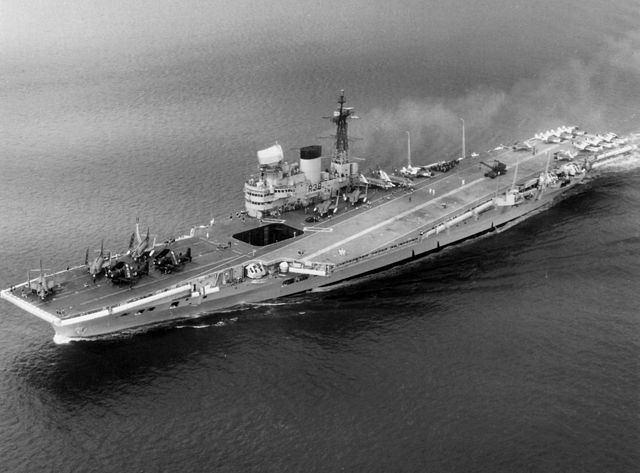
HMS Victorious circa 1959
A well filled career already
HMS Victorious was laid down on N°11 yard of Vickers-Armstrong on the Tyne, on 4 May 1937. She was launched on 14 September 1939, as the war already raged on, and competed much later her sisters due to the yards being short on resources and manpower, but also due to the unavailability of armour plates, on 15 May 1941. By the time she had completed initial (shortened) training, the war in the Mediterranean already changed nature.
Her sister experienced mayhem and herself was hard-pressed, she ferried immediately Hawker Hurricane fighters to Malta, escorted Convoy WS 8B to the Middle East, and during the sortie of the German battleship Bismarck and cruiser Prinz Eugen, still not worked up, with just nine Fairey Swordfish (825 NAS) and a few Fairey Fulmar fighters she took part in the famous hunt, from Scapa Flow with King George V and Repulse. She attacked the battleship without results and lost her in the fog and squalls. It’s Ark Royal that made the winning hit.
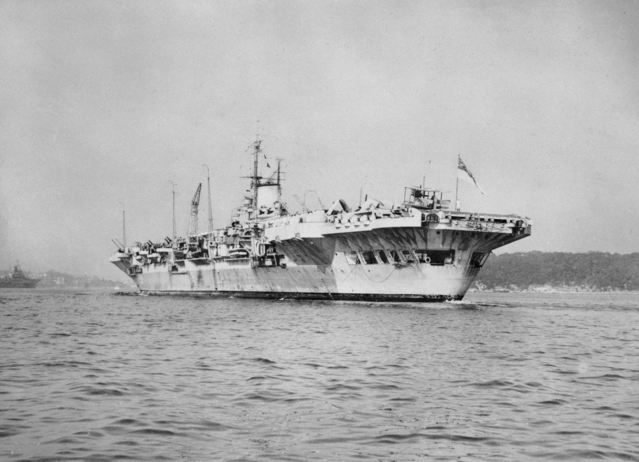
HMS Victorious in Sydney Feb. 1945
Long story short, she took part in Convoy and other Arctic duties until mid-1942, took part in Operation Pedestal (12 August 1942 damaged by Italian bombers), Operation Torch landings, assisting operations on November, and after the USN called for help, after heavy losse sin the Pacific, she was loaned by late December 1942 to the US Navy, modified at Norfolk and sporting Grumman Avengers. She covered USS Saratoga, was assigned in TF14 and later Task Group 36.3, taking part in the New Georgia campaign (Operation Cartwheel).
After refit in Liverpool by March 1944, she took part in the attacks on KMS Tirpitz in Norway, but they failed and she spent the remainder of the year in shipping attacks off Norway (Operation Lombard), before heading for the far east in the Eastern Fleet and later the BPF: Operation Crimson on 25 July (Sumatra), Operation Boomerang, Banquet, Light, Millet, Robson, Lentil, Meridian, and eventually covering the American assault on Okinawa in the 1st Carrier Sqn. she took part in Operations Iceberg I and Iceberg II, and Formosa attack (Operation Iceberg Oolong). Like her sister she was attacked and hit by Kamikaze on 4 and 9 May, with a near-miss on 1 April, but she resisted superbly well, like her sisters, forcing the admiration of US commanders. She took part in the last summer raids in the summer 1945 with the US 3rd Fleet.
Design of the modernization
Starting anew: Victorious compared to her sisters
When the war ended, she was scheduled to leave for Manus Island with Task Force 37 on 10 August 1945, preparing and training for the anticipated invasion of Japan, Operation Downfall, phase I, Olympic. She did not stayed for occupation duties or carrying POWs and the naval staff retired her instead. Fuel shortages were insurmountable, and her steering faults observed in the Indian Ocean by late 1944 were believed to have continued. Nevertheless, her crew took part as a farewell on 31 August, in the Victory Parade in Sydney. Son, she headed home (see more on her career).
Modernization 1950-57
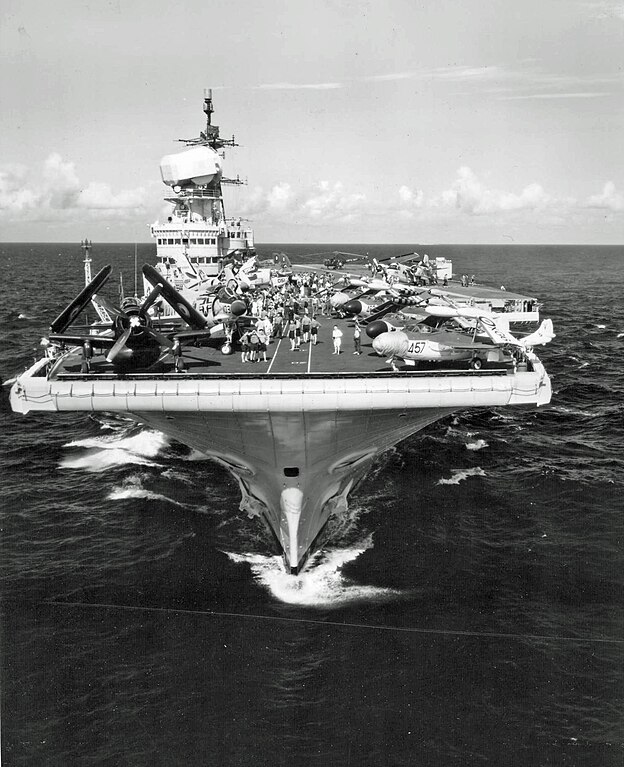
HMS Victorious was virtually rebuilt from 1950 to the end of 1957 to allow her to operate modern jet aircraft. During the process the hull was widened, deepened and lengthened and the machinery and boilers replaced, although it was only decided in 1955 to replace the boilers. Two steam catapults, an angled deck and mirror landing sights were provided, as well as a 3-D radar and faster lifts. The major reconstruction innovation was the provision of a massive sponson on the port side, for the 8.4 degrees angled deck.
This extended the flight deck 35ft 6in outboard, and so she became the first fully angled deck fitted in a British carrier.
The new island rapidly grew in size, with new framing for added structural strength and to support heavier radars. The island was indeed surmounted by a huge ‘searchlight’ array for the Type 984 3-D radar, the first to go to sea. When she was recommissioned on 14 January 1958, HMS Victorious was the most modern British carrier, but although it had originally been hoped that she would operate 54 aircraft, the than 38 (plus eight helicopters) and finally carried only 23 (eight Buccaneers, eight Sea Vixens, two Wessex), see later.
Her crew in 1940 was 817 for the ship alone, and 394 for the air group, so 1,211, and in 1945, 1997, but post refit it grew apparently to a staggering 2,400 including the air group, reflecting on the changes in support, far more intensive for the new jets. Still, it was less than 3600+ on a Forrestal class ship. The increase by almost twice as much personal had detrimental effects on everyday life onboard for obvious reasons, starting with living conditions which were already tough in 1940 but became even less appealing in 1957, and in 1969, completely out of touch with the rest of the fleet in living standards.

HMS Victorious (R38) after reconstruction and modernization. Author’s profile for the future poster.
Armament
In addition one six-barrelled 40mm Mk 6 automatic mounting was positioned on the starboard side between the boạt crane and the after 3in guns. Each gun mounting was controlled by its own CRBF (Close Range Blind Fire) director positioned alongside. She never carried more and the Mk 6 Bofors were removed, former armament was completely replaced by six twin 3in/50 Mk 33 automatic gun on mountings purchased from the US Navy, mounted one on each side forward and two on each to compensate for the weight added.
Protection
She of course inherited her prewar armour design, whuch was excellent but reduced her air group. her armoured belt was 4 inch thick (102 mm), the Hangar sides were also 4 inch thick, wheras the flight deck was 3 inch thick (76 mm) and butressed, the hangar deck was 2 inch (51 mm). The same fire-fighting measures were kept, notably intermediate heavy fireproof curtains, fire posts along the hangar and sprinklers on the roof. To confirm, but it’s likely that extra measures were taken for the fuel delivery lines, the fruit of WW2 experience. In general, all piping and electric network was overhauled and redone in all compartments. The same ASW measures as in the original were kept, alternaitve compartimentation for the turbines and boiler rooms, and extra compartimentation for the under-waterline spaces, filled with oil, and double hull at the bottom.
Sensors
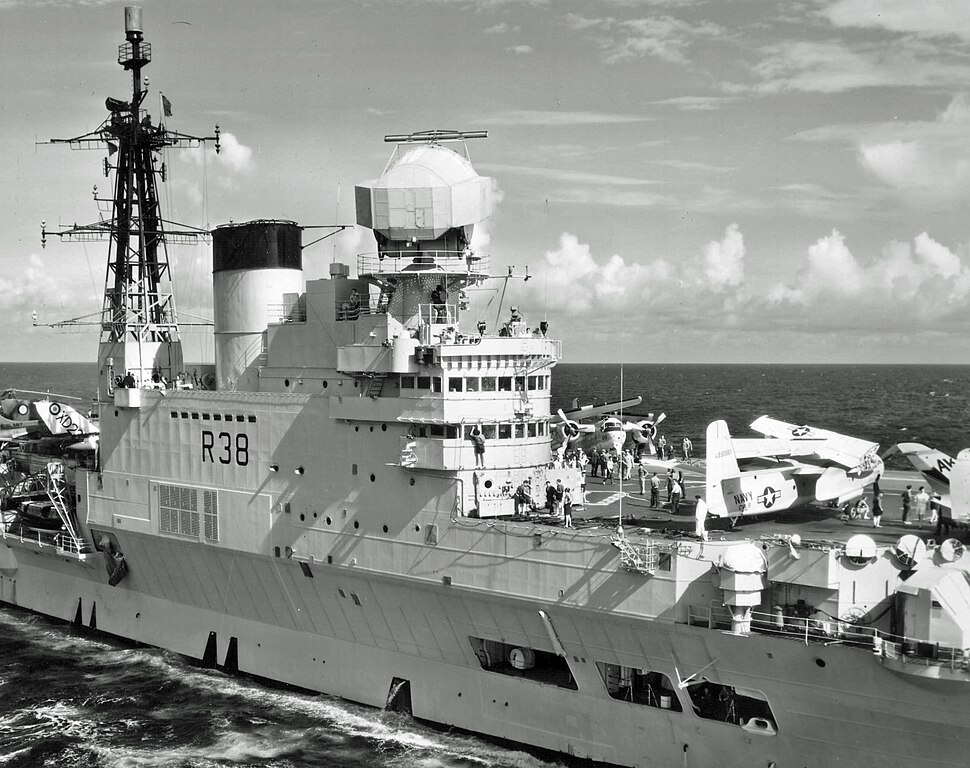
One important aspect of the modernization was the critical upgrade in radars, both for long range watch and gunnery guidance, as technology went far in about five years.
Type 262: Use by 40mm: 30 kW, 9.67 GHz (X-band), PRF 1.5 kHz, pwd 0.5 µs, bmd 5.2° Range 29 nm (54 km)
Type 963: Carrier controlled approach radar, also use by the Centaur class
Type 984: Designed by the Admiralty Signals and Radar Establishment thid was the first RN 3D S band for ground controlled interception and early warning system, most sophisticated of its era.
Range 180 nmi (330 km; 210 mi). HMS Victorious was the first to sport it, colloqually nicknamed the “seachlight”.
Type 974: X-band surface search radar for navigation. 7 kW, FRQ 9,345-9,405 MHz, PRF 1000 Hz pwd 0.14/0.26 µs, RA 25 nm (46 km), acy 2%, bwd 1.6°
Type 293Q: Short RA aerial search, 500 Kw, FRQ 2,997, wvl 100 in service 1945, kept 1957.
Mk 34 radars: Three fire control radars: Dish type, added on the 40 mm bofors mounts for guidance.
Air Group
Her max theoretical air group in 1957 was 36 aircraft of the Sea Hawk and Sea Venom fighters types, Wyvern torpedo bombers, Skyraider attackers, Gannet and Avenger early warning planes, Whirlwind and Sycamore helicopters for SAR and plane guard ASW patrol. In 1959, when her air group was well qualified and cemented in fleet operations, she carried ten Sea Venom FAW.21 and 12 Scimitar F.1 plus 6 Fairey Gannet AS.4. In 1966-68 she operated 849A SQn. with between June 1966 and June 1967 the Gannet AEW3 and Sqn. 801, operating between May 1966 and May 1968 the Blackburn Buccaneer S2.
In 1963 she kept eight Sea Venom FAW.21 to which were added eight Buccaneer S.2 and 5 Gannet AS.4, plus 5 Wessex. It should be noted that the Buccaneer was about the same size as the F4 Phantom and nuclear-capable. Still more capable than Hermes, she was still too small to operate larger aircraft unlike Eagle and Ark Royal.

De Havilland Sea Vixen FAW.2, 893 NAS Victorious 1958 – Two-seat all-weather interception and strike aircraft

Supermarine Scimitar F.1, 803 NAS HMS Victorious 1958

Blackburn Buccaneer, her 2-seat low-level strike aircraft, last and heaviest jet to operate aboard. XN977, NAS 801 HMS Victorious 1965
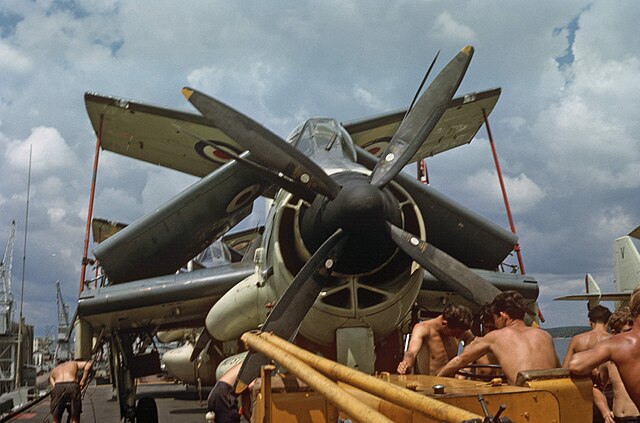
HMS Victorious in Singapore, 1964: Fairey Gannet, wings folded.
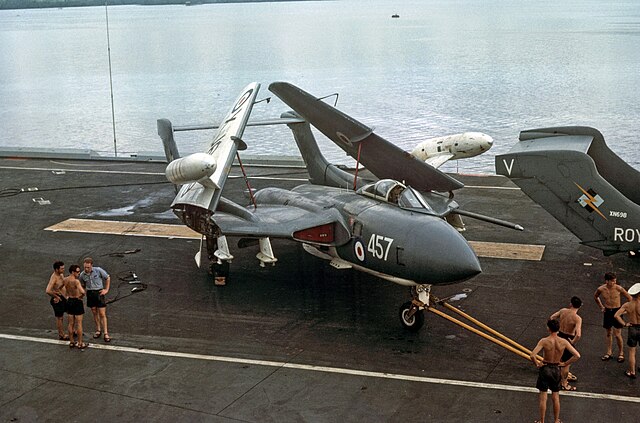
De Havilland Sea Vixens FAW 21 being towed to the catapult
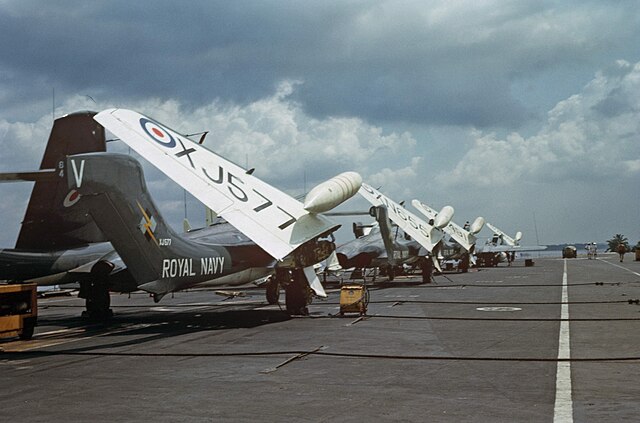
Vixens parked along the landing deck, being readied for launch in turn
She operated the following:
De Havilland Sea Venom: Sqn 894 (Feb 1959, June-August 1959 and Sqn 805 April-May 1961
Supermarine Scimitar: Sqn 803 (Sep 1958-February 1960 and Sqn 807 January 1960
De Havilland Sea Vixen: 893 Sqn from Aug. 1963 to June 1967, 892 Sqn from Oct. 1959 and Oct0 1960 Febr. 1962
Blackburn Buccaneer: Sqn 809 (July-Aug. 1963, May-June 1966; Sqn 801 Aug 1963-June 1967
Fairey Gannet: Sqn 849B (Oct. 1960-Feb. 1962, Sqn 849A Aug. 1963 – June 1967
Westland Whirlwind: Sqn 701 Feb. 1958, Sqn 824 Aug. 1958 – Jan 1959, Sqn 825 Oct. 1960 – Nov. 1961
Westland Wessex: Sqn 815 Dec. 1961, Sqn 814 Aug 1963- July 1965, April- Sept. 1966, Jan- March 1967
⚙ specifications 1957 |
|
| Displacement | 30,530/35,500 tonnes FL |
| Dimensions | 225.5/238m x 31,5/47.8 m x 9.5 m (781 ft x 103 ft 6 inch wl/157 ft fd x 31 ft) |
| Propulsion | 3 shaft Parsons GST, 6 Fosters Wheeler Boilers 110,000 shp |
| Speed | 31 kts (nominal) |
| Range | 10,000 nm/20 kts |
| Armament | 12x 3-in/50 Mk33, 6x 40mm Mk6 AA |
| Protection | Belt 102, hangar sides 102, flight deck 76, hangar deck 51 mm |
| Sensors | Radar 984, 974 193Q |
| Air Group | 36 aircrafts as modernized |
| Crew | 2400 |
The cold war career of HMS Victorious (1957-1968)
HMS Victorious left Australia in September 1945 and was home by 27 October, starting after preps a serie of trips to bring back servicemen and war brides from Australia and Far East. In the winter 1946–47, she was in home waters for pilot qualifications, performing the first deck trials with the Hawker Sea Fury Fb.Mark 10 until approval for operations in January.
After this in the postwar context she was placed in reserve at Devonport, on 15 January 1947, and by June, took to Portsmouth Dockyard to received additional accommodation and classrooms as a training career. By October 1947, she joined as intended the Home Fleet Training Squadron in place of battleship Nelson and by July 1948, she was in Portland Harbour for the 1948 London Olympic Games. In 1949 she entered Rosyth for a refit, followed by training cruises and Home Fleet exercises, a pattern that was seen as leading to a future quiet retirement in 1950.
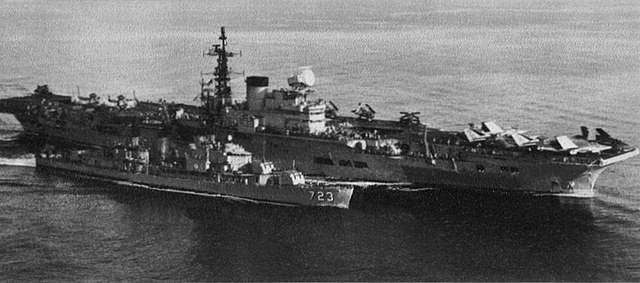
Major reconstruction 1950-57
However the admiralty had other plans, including converting armoured carrier to jet operations. Thus, she was drydocked for an extensive cycle of reconstruction and modernisation at Portsmouth Dockyard, starting in 1950 instead. Due to the long process, going up to 1958, she completely missed the Korean war, unlike her sisters. Apart some budget priorities changes, the delays were caused by some systems long to develop than anticipated but also and above all, frequent design changes to integrate new systems as they came. The 1953 decision to completely overhaul her machinery was probably the most damming as she was gutted to access those, meaning removing brand new systems that were already in place. The original steam turbines were replaced in order to still be running past 1964 and she received brand new and state of art Foster-Wheeler boilers. Her new flight deck was also dismounted and replaced again.
Cost of the reconstruction in the end, went from a modest 5 million pounds, to a balooning 30 million pounds, but her hull was also widened, deepened, and lengthened for better stability. Her hangar height was increased to deal with new aircraft to 5.25m () for a total of 5,690 m² or 29,869 m³ in volume, the flight deck reaching 6,366 m², with two new faster, heavy duty lifts installed and angle ported to 8.75°. Electric generating capacity doubled. New artillery fitted with 3 inch (76 mm) guns . The flight deck was stranghtened especially the angle sponson later in 1962-63 but keeping the same angle, but with new and more powerful 44m () steam catapults steam catapults unchanged. The radar equipment was also modified, notably to hoist for the first time in the Royal Navy, the type 984 3-D radar system. She became almost the equivalent in this regard of USS Enterprise.
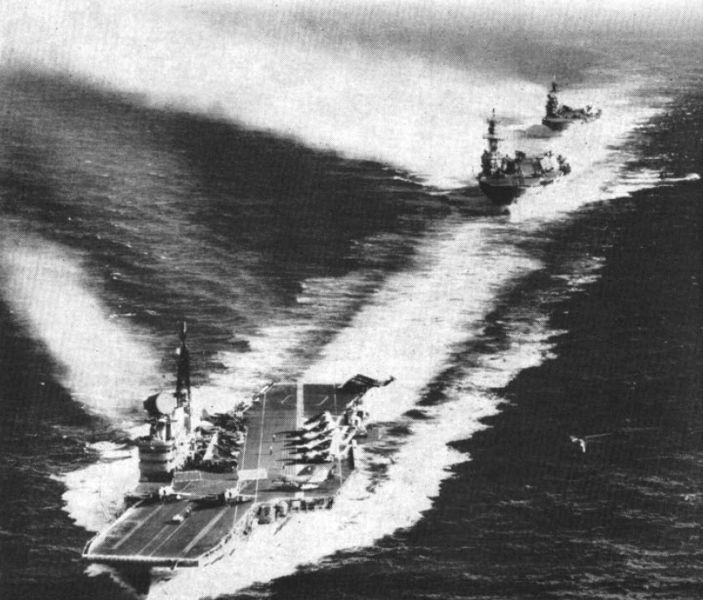
Victorious leads Ark Royal and Hermes in 1961
Early Mediterranean cold war service 1958-63
After the reconstruction was completed she was recommission on 14 January 1958 and started sea trials, then initial training, wepons, sensors, and soon air group pilots qualifications. On 25 September 1958, Cdr J. D. Russell died when landing his Supermarine Scimitar for the first jet landing attempt. Despite having engaged the arrestor wire with his landing hook, the wire snapped due to improper rigging, the aicraft helplessely rolled slowly over the side and fell nose first, sinking like a brick, despite the presence of a plane-guard helicopter. Some asserted that even the canopy was opened, the diving speed and increased pressure closed it down again.
In 1960, she started fleet deployments in the Atlantic and Mediterranean. She was requisitioned for the British firlm industry to potray HMS Ark Royal for “Sink the Bismarck”. There was a cameo by actor Kenneth More which served aboard as junior officer, and there as Admiralty Director of Operations. HMS Victorious took part in Operation Vantage off Kuwait, July 1961. The same year later she sailed for the Far East Fleet and stayed on station for a few years.
Modernization 1962-63
During the 1962-63 refit the flight deck was strengthened, and an access gangway was provided outboard of the island. The ‘flyco’ on the inboard side of the island was extended and enlarged and the mirror sights were replaced by projector sights. Two parallel-track 145ft steam catapults were provided and because of the angled deck there were only four arrester wires, each with an average span of 80ft. A major internal improvement was to nearly double the generating capacity to 4200 kW, but even this had to be increased to 5000 kW in 1962-63. During the May 1962-August 1963 refit two 3in mountings were removed, fire posts enlarged, and the mirror sights were replaced by projector sights.
The Malayan crisis and Far East Operations 1964-67
In 1964, came her greatest engagement: She provided support for the newly indpendent Malaysia, amidst border disputes with Indonesia. When crossing the Sunda Strait this caused international proptestations, notably by USSR, to which Indonesia was a “protegee”, and a crisis developed between August and September 1964. Until Indonesia agreed to allow Victorious to return through via Lombok Strait. April 1966 saw her second Far East Fleet deplyment for over a year, and for the first time, she went to the Philippines to test the new USN Phantom F-4 from USS Ranger, with the intention of perhaps operating it. She sailed back home for a refit, starting in June 1967. Nobody knew at the time, that her career was about to end soon.
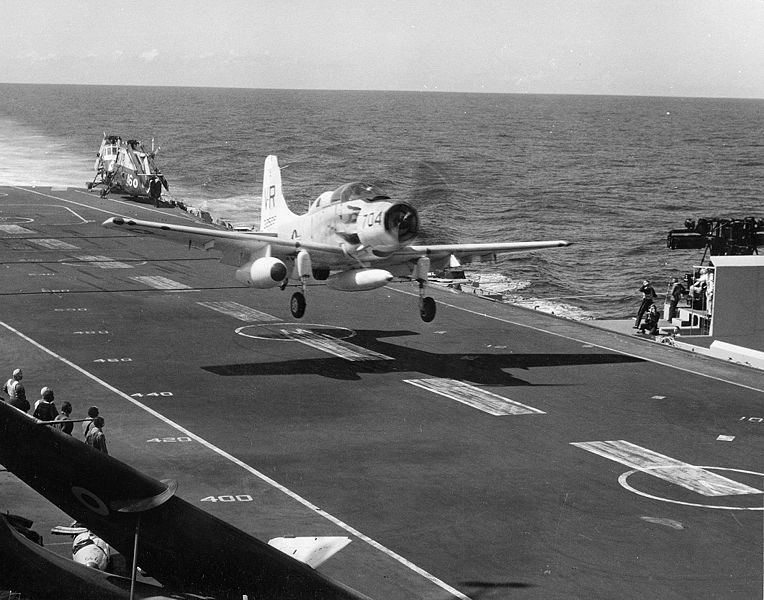
A US Navy Douglas EA-1F Skyraider (electronics countermeasures aircraft) making a touch-and-go landing on HMS Victorious in 1963
Last refit and decommission 1967-69
On 11 November 1967, her 1967 refit almost complete, there was a relatively small fire in chief petty officers’ mess (origin not well understood), rapidly extinguished. But it caused one death and two badly burned, intoxicated personal. Damage was minor but was reported, and it came after a white paper, pleading for a massive defence budget cut, as well as manpower shortage. It was in addition stricken by the brash 1966 decision to phase out fixed-wing naval aviation altogether. Soon the axe fell, no recommission for Victorious, her captain, McIntosh, being informed just one day before the ceremony. The crew insisted to make one anyway as a farewell, and she was paid off in 1968, on Disposal List in 1969 and sold to local Shipbreakers, towed on 13 July 1969 to Faslane for BU.
Successive captains: Captain CP Coke DSO RN from 16 December 1957, HRB Janvrin DSC RN from 11 August 1959, JMD Gray OBE RN from 21 December 1960, PM Compston RN from 19 November 1962, DL Davenport OBE RN from 6 October 1964 and her last, IL McIntosh DSO DSC MBE from 12 September 1966 until decommission.

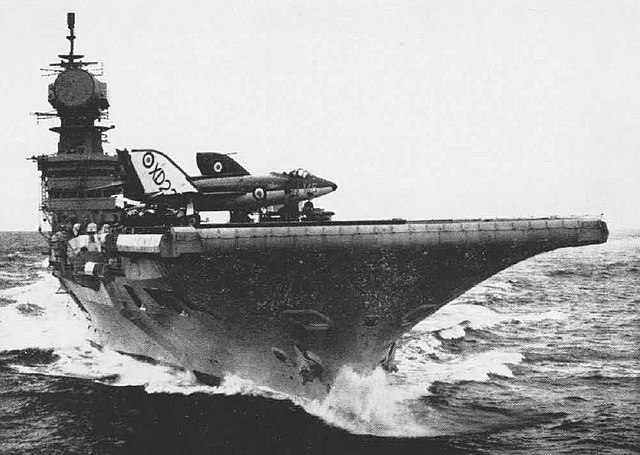
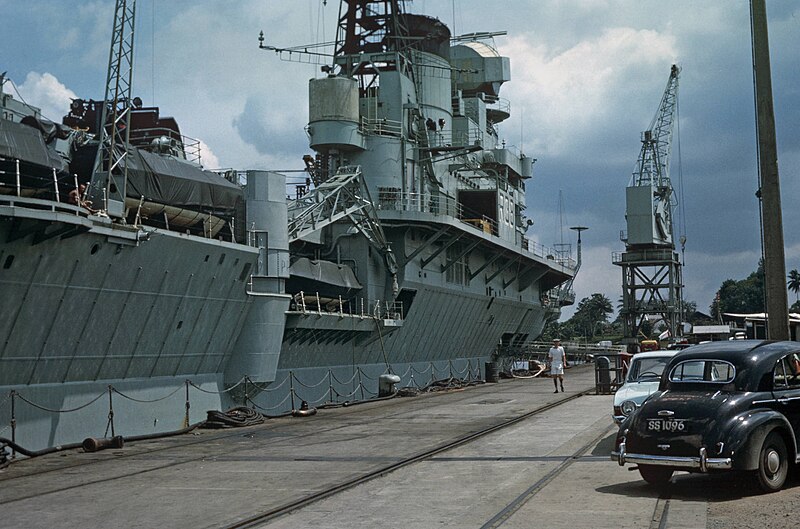
Read More/Src
Books
Apps, Michael (1971). Send Her Victorious. London: William Kimber & Co.
Blair, Clay (2000). Hitler’s U-Boat War: The Hunters 1939–1942. London: Cassell & Co.
Chesneau, Roger (1998). Aircraft Carriers of the World, 1914 to the Present. Brockhampton Press.
Garzke, William; Dulin, Robert; Jurens, William (2019). Battleship Bismarck. Naval Institute Press.
Hobbs, David (2013). British Aircraft Carriers: Design, Development and Service Histories. Seaforth Publishing.
Hobbs, David (2011). The British Pacific Fleet: The Royal Navy’s Most Powerful Strike Force. Seaforth Publishing.
Hobbs, D (December 2014). “HMS Victorious: The Highly Adaptable Carrier”.
Jenkins, C. A. (1972). HMS Furious/Aircraft Carrier 1917–1948: Part II: 1925–1948. Profile Publications.
Kennedy, Ludovic (1984). Pursuit: The Chase and Sinking of the Bismarck. Bantam Books.
Konstam, Angus (2018). Sink the Tirpitz 1942–44: The RAF and Fleet Air Arm Duel with Germany’s Mighty Battleship. Osprey Publishing.
Preston, Antony (1995). “United Kingdom”. In Chumbley, Stephen (ed.). Conway’s All the World’s Fighting Ships 1947-1995.
Rohwer, Jürgen; Hümmelchen, Gerhard (1992). Chronology of the War at Sea 1939–1945. Greenhill Books.
Ruegg, Bob; Hague, Arnold (1993). Convoys to Russia 1941–1945. Kendal, UK: World Ship Society.
Shores, Christopher; Cull, Brian; Malizia, Nicola (1987). Malta: The Hurricane Years. London: Grub Street.
Sturtivant, Ray; Ballance, Theo (1994). The Squadrons of the Fleet Air Arm. Tonbridge, UK: Air Britain
Vian, Philip (1960). Action This Day. London: Frederick Muller.
Watton, Ross (1991). The Aircraft Carrier Victorious. Anatomy of the Ship. Naval Institute Press.
Belote, James (1975). Titans of the Seas. New York: Harper & Row.
Blackman, V. B, ed. (1951). Jane’s Fighting Ships 1950–51. Sampson Low, Marston.
Friedman, Norman (1988). British Carrier Aviation: The Evolution of the Ships and Their Aircraft. NIP
Hobbs, David (2020). “The Reconstruction of HMS Victorious”. Warship 2020. Osprey.
Links
http://www.maritimequest.com/warship_directory/great_britain/pages/aircraft_carriers/hms_victorious_38.htm
https://www.armouredcarriers.com/
https://api.parliament.uk/historic-hansard/written-answers/1967/nov/16/hms-victorious-fire
https://web.archive.org/web/20110728095526/http://www.seavixen.org/index.cfm?fa=contentGeneric.amsybmvkhafrbbal&pageId=56720
https://web.archive.org/web/20100323224306/http://www.fleetairarmarchive.net/Ships/Victorious.html
https://web.archive.org/web/20160827142131/http://www.fleetairarmarchive.net/aircraft/Seafury.html
https://en.wikipedia.org/wiki/HMS_Victorious_(R38)
https://www.navypedia.org/ships/uk/brit_cv1_illustrious.htm
http://www.wings-aviation.ch/32-FAA/3-Carrier/Fleet/Victorious/Victorious.htm
Videos
Model Kits
Most praised: airfix hms-victorious 1:600
More on scalemates
3D
Not found yet

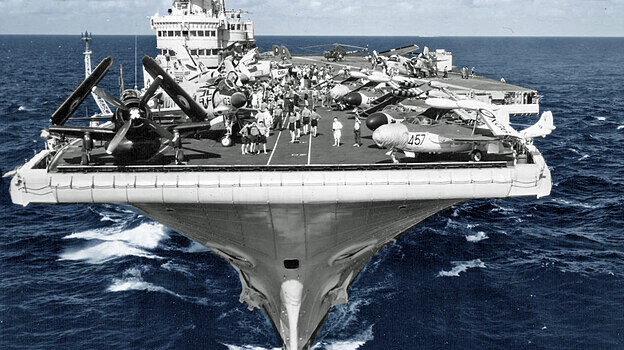
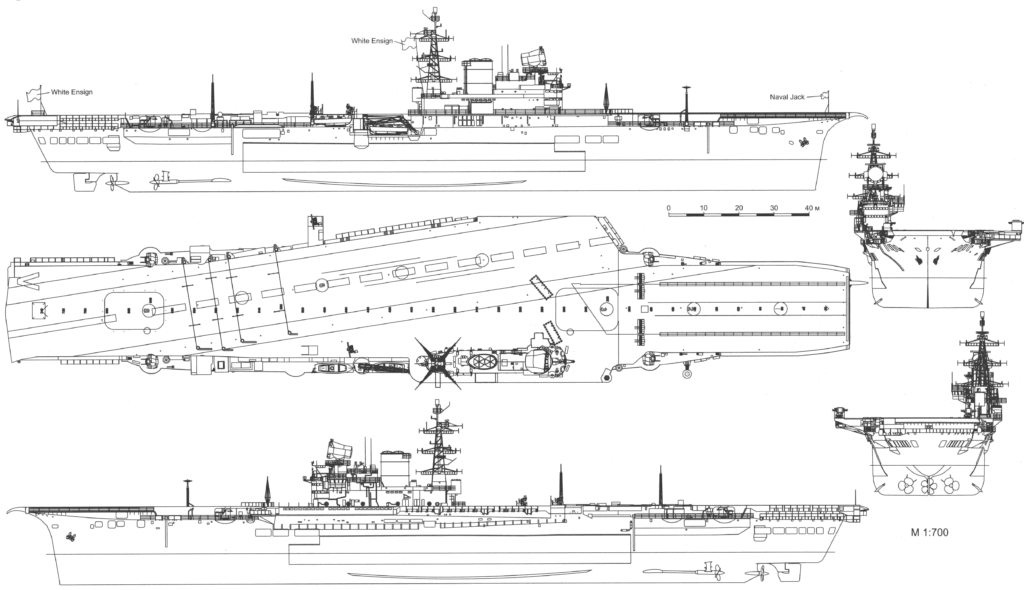
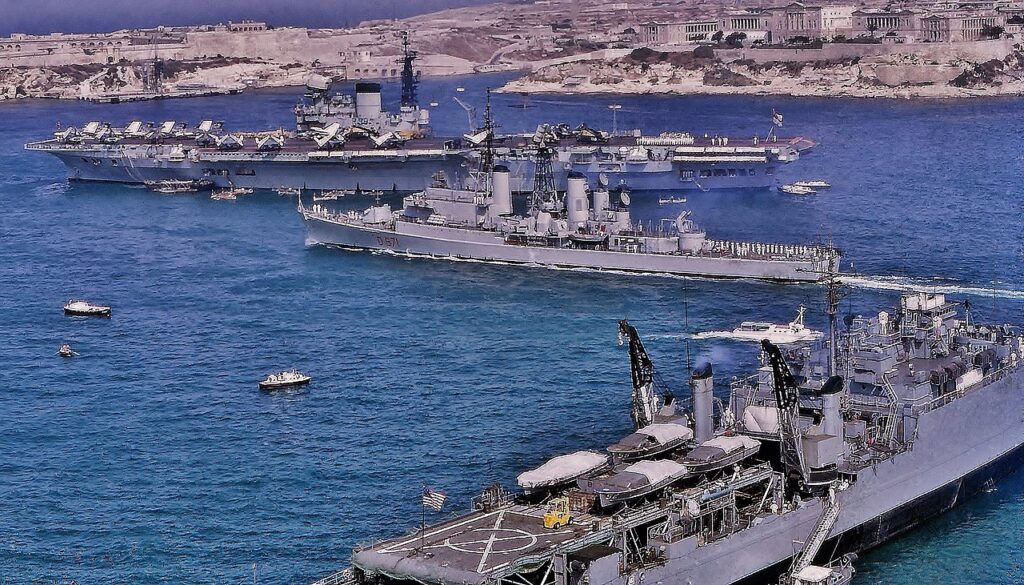
 Latest Facebook Entry -
Latest Facebook Entry -  X(Tweeter) Naval Encyclopedia's deck archive
X(Tweeter) Naval Encyclopedia's deck archive Instagram (@navalencyc)
Instagram (@navalencyc)





 French Navy
French Navy Royal Navy
Royal Navy Russian Navy
Russian Navy Armada Espanola
Armada Espanola Austrian Navy
Austrian Navy K.u.K. Kriegsmarine
K.u.K. Kriegsmarine Dansk Marine
Dansk Marine Nautiko Hellenon
Nautiko Hellenon Koninklije Marine 1870
Koninklije Marine 1870 Marinha do Brasil
Marinha do Brasil Osmanlı Donanması
Osmanlı Donanması Marina Do Peru
Marina Do Peru Marinha do Portugal
Marinha do Portugal Regia Marina 1870
Regia Marina 1870 Nihhon Kaigun 1870
Nihhon Kaigun 1870 Preußische Marine 1870
Preußische Marine 1870 Russkiy Flot 1870
Russkiy Flot 1870 Svenska marinen
Svenska marinen Søværnet
Søværnet Union Navy
Union Navy Confederate Navy
Confederate Navy Armada de Argentina
Armada de Argentina Imperial Chinese Navy
Imperial Chinese Navy Marinha do Portugal
Marinha do Portugal Mexico
Mexico Kaiserliche Marine
Kaiserliche Marine 1898 US Navy
1898 US Navy Sovietskiy Flot
Sovietskiy Flot Royal Canadian Navy
Royal Canadian Navy Royal Australian Navy
Royal Australian Navy RNZN Fleet
RNZN Fleet Chinese Navy 1937
Chinese Navy 1937 Kriegsmarine
Kriegsmarine Chilean Navy
Chilean Navy Danish Navy
Danish Navy Finnish Navy
Finnish Navy Hellenic Navy
Hellenic Navy Polish Navy
Polish Navy Romanian Navy
Romanian Navy Turkish Navy
Turkish Navy Royal Yugoslav Navy
Royal Yugoslav Navy Royal Thai Navy
Royal Thai Navy Minor Navies
Minor Navies Albania
Albania Austria
Austria Belgium
Belgium Columbia
Columbia Costa Rica
Costa Rica Cuba
Cuba Czechoslovakia
Czechoslovakia Dominican Republic
Dominican Republic Haiti
Haiti Hungary
Hungary Honduras
Honduras Estonia
Estonia Iceland
Iceland Eire
Eire Equador
Equador Iran
Iran Iraq
Iraq Latvia
Latvia Liberia
Liberia Lithuania
Lithuania Mandchukuo
Mandchukuo Morocco
Morocco Nicaragua
Nicaragua Persia
Persia San Salvador
San Salvador Sarawak
Sarawak Uruguay
Uruguay Venezuela
Venezuela Zanzibar
Zanzibar Warsaw Pact Navies
Warsaw Pact Navies Bulgaria
Bulgaria Hungary
Hungary

 Bundesmarine
Bundesmarine Dutch Navy
Dutch Navy Hellenic Navy
Hellenic Navy Marina Militare
Marina Militare Yugoslav Navy
Yugoslav Navy Chinese Navy
Chinese Navy Indian Navy
Indian Navy Indonesian Navy
Indonesian Navy JMSDF
JMSDF North Korean Navy
North Korean Navy Pakistani Navy
Pakistani Navy Philippines Navy
Philippines Navy ROKN
ROKN Rep. of Singapore Navy
Rep. of Singapore Navy Taiwanese Navy
Taiwanese Navy IDF Navy
IDF Navy Saudi Navy
Saudi Navy Royal New Zealand Navy
Royal New Zealand Navy Egyptian Navy
Egyptian Navy South African Navy
South African Navy






























 Ukrainian Navy
Ukrainian Navy dbodesign
dbodesign
In your captions of the De Havilland Sea Vixen the aircraft are misidentified as Sea Venom.
You’re right, fixed !